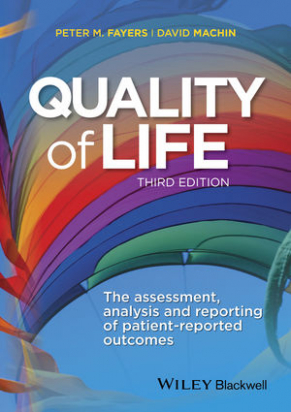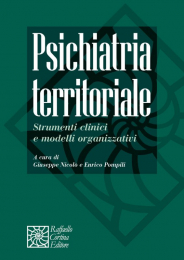Non ci sono recensioni
The assessment of patient reported outcomes and health-related quality of life continue to be rapidly evolving areas of research and this new edition reflects the development within the field from an emerging subject to one that is an essential part of the assessment of clinical trials and other clinical studies.
The analysis and interpretation of quality-of-life assessments relies on a variety of psychometric and statistical methods which are explained in this book in a non-technical way. The result is a practical guide that covers a wide range of methods and emphasizes the use of simple techniques that are illustrated with numerous examples, with extensive chapters covering qualitative and quantitative methods and the impact of guidelines. The material in this new third edition reflects current teaching methods and content widened to address continuing developments in item response theory, computer adaptive testing, analyses with missing data, analysis of ordinal data, systematic reviews and meta-analysis.
This book is aimed at everyone involved in quality-of-life research and is applicable to medical and non-medical, statistical and non-statistical readers. It is of particular relevance for clinical and biomedical researchers within both the pharmaceutical industry and clinical practice.
Preface to the third edition xiii
Preface to the second edition xv
Preface to the fi rst edition xvii
List of abbreviations xix
PART 1 Developing and Validating Instruments for Assessing Quality of Life and Patient-Reported Outcomes
1 Introduction 3
1.1 Patient ]reported outcomes 3
1.2 What is a patient ]reported outcome? 4
1.3 What is quality of life? 4
1.4 Historical development 6
1.5 Why measure quality of life? 9
1.6 Which clinical trials should assess QoL? 17
1.7 How to measure quality of life 18
1.8 Instruments 19
1.9 Computer ]adaptive instruments 32
1.10 Conclusions 32
2 Principles of measurement scales 35
2.1 Introduction 35
2.2 Scales and items 35
2.3 Constructs and latent variables 36
2.4 Single global questions versus multi ]item scales 37
2.5 Single ]item versus multi ]item scales 40
2.6 Effect indicators and causal indicators 42
2.7 Psychometrics, factor analysis and item response theory 48
2.8 Psychometric versus clinimetric scales 52
2.9 Suffi cient causes, necessary causes and scoring items 53
2.10 Discriminative, evaluative and predictive instruments 54
2.11 Measuring quality of life: refl ective, causal and composite indicators? 55
2.12 Further reading 56
2.13 Conclusions 56
3 Developing a questionnaire 57
3.1 Introduction 57
3.2 General issues 58
3.3 Defining the target population 58
3.4 Phases of development 59
3.5 Phase 1: Generation of issues 61
3.6 Qualitative methods 63
3.7 Sample sizes 66
3.8 Phase 2: Developing items 68
3.9 Multi ]item scales 72
3.10 Wording of questions 73
3.11 Face and content validity of the proposed questionnaire 74
3.12 Phase 3: Pre ]testing the questionnaire 74
3.13 Cognitive interviewing 77
3.14 Translation 80
3.15 Phase 4: Field ]testing 80
3.16 Conclusions 86
3.17 Further reading 87
4 Scores and measurements: validity, reliability, sensitivity 89
4.1 Introduction 89
4.2 Content validity 90
4.3 Criterion validity 94
4.4 Construct validity 96
4.5 Repeated assessments and change over time 104
4.6 Reliability 104
4.7 Sensitivity and responsiveness 117
4.8 Conclusions 124
4.9 Further reading 124
5 Multi ]item scales 125
5.1 Introduction 125
5.2 Significance tests 126
5.3 Correlations 127
5.4 Construct validity 133
5.5 Cronbach’s α and internal consistency 139
5.6 Validation or alteration? 143
5.7 Implications for formative or causal items 144
5.8 Conclusions 147
6 Factor analysis and structural equation modelling 149
6.1 Introduction 149
6.2 Correlation patterns 150
6.3 Path diagrams 152
6.4 Factor analysis 154
6.5 Factor analysis of the HADS questionnaire 154
6.6 Uses of factor analysis 159
6.7 Applying factor analysis: Choices and decisions 161
6.8 Assumptions for factor analysis 167
6.9 Factor analysis in QoL research 171
6.10 Limitations of correlation-based analysis 172
6.11 Formative or causal models 173
6.12 Confirmatory factor analysis and structural equation modelling 176
6.13 Chi-square goodness-of-fit test 178
6.14 Approximate goodness-of-fit indices 180
6.15 Comparative fit of models 181
6.16 Difficulty-factors 182
6.17 Bifactor analysis 183
6.18 Do formative or causal relationships matter? 186
6.19 Conclusions 187
6.20 Further reading, and software 188
7 Item response theory and differential item functioning 189
7.1 Introduction 189
7.2 Item characteristic curves 191
7.3 Logistic models 193
7.4 Polytomous item response theory models 196
7.5 Applying logistic IRT models 197
7.6 Assumptions of IRT models 205
7.7 Fitting item response theory models: Tips 208
7.8 Test design and validation 209
7.9 IRT versus traditional and Guttman scales 209
7.10 Differential item functioning 210
7.11 Sample size for DIF analyses 218
7.12 Quantifying differential item functioning 219
7.13 Exploring differential item functioning: Tips 219
7.14 Conclusions 221
7.15 Further reading, and software 222
8 Item banks, item linking and computer-adaptive tests 223
8.1 Introduction 223
8.2 Item bank 224
8.3 Item evaluation, reduction and calibration 226
8.4 Item linking and test equating 228
8.5 Test information 231
8.6 Computer-adaptive testing 232
8.7 Stopping rules and simulations 235
8.8 Computer-adaptive testing software 236
8.9 CATs for PROs 237
8.10 Computer-assisted tests 238
8.11 Short-form tests 239
8.12 Conclusions 239
8.13 Further reading 240
PART 2 Assessing, Analysing and Reporting Patient-Reported Outcomes and the Quality of Life of Patients
9 Choosing and scoring questionnaires 243
9.1 Introduction 243
9.2 Finding instruments 244
9.3 Generic versus specific 245
9.4 Content and presentation 246
9.5 Choice of instrument 247
9.6 Scoring multi-item scales 250
9.7 Conclusions 256
9.8 Further reading 257
10 Clinical trials 259
10.1 Introduction 259
10.2 Basic design issues 260
10.3 Compliance 262
10.4 Administering a quality ]of ]life assessment 268
10.5 Recommendations for writing protocols 270
10.6 Standard operating procedures 280
10.7 Summary and checklist 281
10.8 Further reading 282
11 Sample sizes 283
11.1 Introduction 283
11.2 Signifi cance tests, p ]values and power 284
11.3 Estimating sample size 284
11.4 Comparing two groups 289
11.5 Comparison with a reference population 298
11.6 Non ]inferiority studies 298
11.7 Choice of sample size method 301
11.8 Non ]Normal distributions 302
11.9 Multiple testing 303
11.10 Specifying the target difference 305
11.11 Sample size estimation is pre ]study 305
11.12 Attrition 306
11.13 Circumspection 306
11.14 Conclusion 306
11.15 Further reading 307
12 Cross ]sectional analysis 309
12.1 Types of data 309
12.2 Comparing two groups 312
12.3 Adjusting for covariates 324
12.4 Changes from baseline 330
12.5 Analysis of variance 331
12.6 Analysis of variance models 336
12.7 Graphical summaries 337
12.8 Endpoints 342
12.9 Conclusions 343
13 Exploring longitudinal data 345
13.1 Area under the curve 345
13.2 Graphical presentations 348
13.3 Tabular presentations 358
13.4 Reporting 360
13.5 Conclusions 365
14 Modelling longitudinal data 367
14.1 Preliminaries 367
14.2 Auto-correlation 368
14.3 Repeated measures 373
14.4 Other situations 388
14.5 Modelling versus area under the curve 389
14.6 Conclusions 390
15 Missing data 393
15.1 Introduction 393
15.2 Why do missing data matter? 396
15.3 Types of missing data 400
15.4 Missing items 403
15.5 Methods for missing items within a form 404
15.6 Missing forms 408
15.7 Methods for missing forms 410
15.8 Simple methods for missing forms 410
15.9 Methods of imputation that incorporate variability 415
15.10 Multiple imputation 421
15.11 Pattern mixture models 422
15.12 Comments 424
15.13 Degrees of freedom 425
15.14 Sensitivity analysis 426
15.15 Conclusions 426
15.16 Further reading 427
16 Practical and reporting issues 429
16.1 Introduction 429
16.2 The reporting of design issues 430
16.3 Data analysis 430
16.4 Elements of good graphics 436
16.5 Some errors 440
16.6 Guidelines for reporting 442
16.7 Further reading 445
17 Death, and quality-adjusted survival 447
17.1 Introduction 447
17.2 Attrition due to death 448
17.3 Preferences and utilities 449
17.4 Multi-attribute utility (MAU) measures 453
17.5 Utility-based instruments 454
17.6 Quality-adjusted life years (QALYs) 456
17.7 Utilities for traditional instruments 457
17.8 Q-TWiST 462
17.9 Sensitivity analysis 467
17.10 Prognosis and variation with time 470
17.11 Alternatives to QALY 472
17.12 Conclusions 473
17.13 Further reading 474
18 Clinical interpretation 475
18.1 Introduction 475
18.2 Statistical signifi cance 476
18.3 Absolute levels and changes over time 477
18.4 Threshold values: percentages 478
18.5 Population norms 479
18.6 Minimal important difference 488
18.7 Anchoring against other measurements 492
18.8 Minimum detectable change 493
18.9 Expert judgement for evidence-based guidelines 494
18.10 Impact of the state of quality of life 495
18.11 Changes in relation to life events 496
18.12 Effect size statistics 498
18.13 Patient variability 505
18.14 Number needed to treat 506
18.15 Conclusions 509
18.16 Further reading 509
19 Biased reporting and response shift 511
19.1 Bias 511
19.2 Recall bias 512
19.3 Selective reporting bias 513
19.4 Other biases affecting PROs 514
19.5 Response shift 516
19.6 Assessing response shift 521
19.7 Impact of response shift 523
19.8 Clinical trials 523
19.9 Non ]randomised studies 525
19.10 Conclusions 526
20 Meta ]analysis 527
20.1 Introduction 527
20.2 Defining objectives 528
20.3 Defining outcomes 528
20.4 Literature searching 528
20.5 Assessing quality 529
20.6 Summarising results 533
20.7 Measures of treatment effect 534
20.8 Combining studies 537
20.9 Forest plot 542
20.10 Heterogeneity 542
20.11 Publication bias and funnel plots 544
20.12 Conclusions 545
20.13 Further reading 546
Appendix 1: Examples of instruments 547
Generic instruments
E1 Sickness Impact Profi le (SIP) 549
E2 Nottingham Health Profi le (NHP) 551
E3 SF36v2TM Health Survey Standard Version 552
E4 EuroQoL EQ-5D-5L 555
E5 Patient Generated Index of quality of life (PGI) 557
Disease-specific instruments 559
E6 European Organisation for Research and Treatment of Cancer QLQ-C30 (EORTC QLQ-C30) 559
E7 Elderly cancer patients module (EORTC QLQ-ELD14) 561
E8 Functional Assessment of Cancer Therapy – General (FACT-G) 562
E9 Rotterdam Symptom Checklist (RSCL) 564
E10 Quality of Life in Epilepsy Inventory (QOLIE-89) 566
E11 Paediatric Asthma Quality of Life Questionnaire (PAQLQ) 570
Domain-specifi c instruments 573
E12 Hospital Anxiety and Depression Scale (HADS) 573
E13 Short-Form McGill Pain Questionnaire (SF-MPQ) 574
E14 Multidimensional Fatigue Inventory (MFI-20) 575
ADL and disability 577
E 15 (Modifi ed) Barthel Index of Disability (MBI) 577
Appendix 2: Statistical tables 579
Table T1: Normal distribution 579
Table T2: Probability points of the Normal distribution 581
Table T3: Student’s t ]distribution 582
Table T4: The χ2 distribution 583
Table T5: The F ]distribution 584
References 585
Index 613




